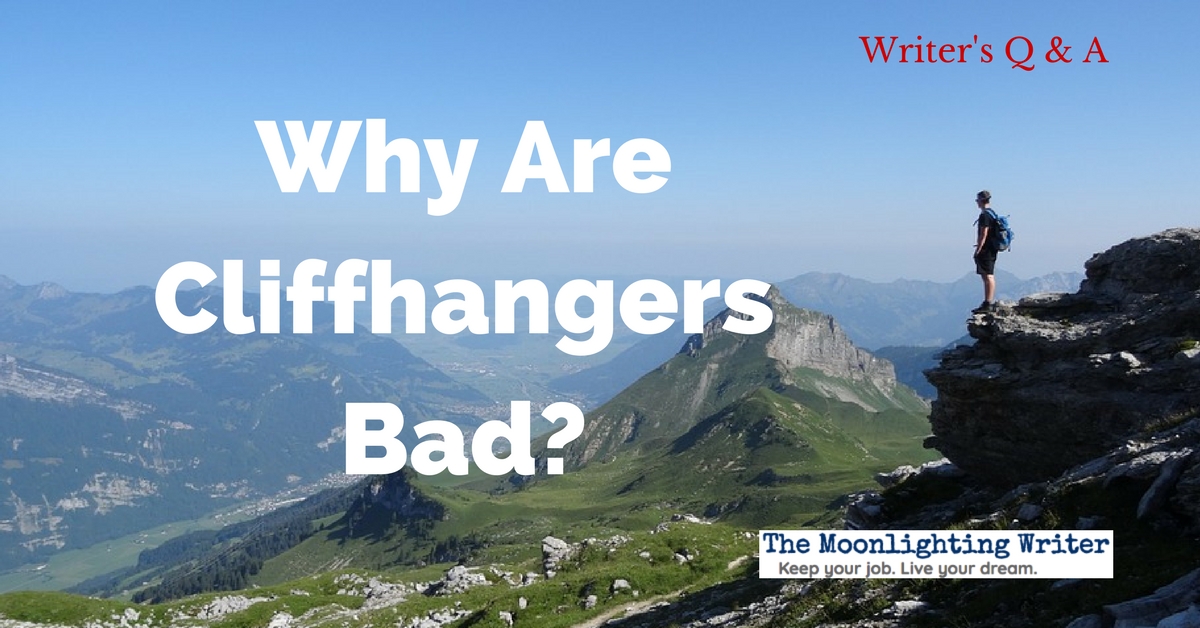One of the most common frustrations expressed by fans of fiction in TV, movies, and books is the proliferation of the cliffhanger. When a story seems like it’s building to a satisfactory ending and then just STOPS, the reader or viewer is first jolted out of his groove and then bristled into irritation.
“Hey … you mean I have to read another book?!”
Or at least that’s the theory about why cliffhangers are bad. But, as with most issues in writing, the villainosity of cliffhangers is not quite so black-and-white.
In fact, not all “cliffhangers” are even cliffhangers at all.
4 Types of Unresolved Endings
As author Jennifer Ellis notes in her blog, there are (at least) four types of unresolved endings:
The True Cliffhanger
Something big happens, or is about to happen, to a main character, and then the story stops. You know there will be a follow-up in this case.
The Ambiguous Ending
The ending is unclear, leaving it open to reader interpretation. When the cowboy rides off into the sunset, is he going to find his lost love, or to hunt down his arch nemesis? There probably won’t be a sequel, but maybe …
Dangling Plot Lines
Most of the main story lines are resolved, and the main characters have reached a sort of equilibrium. But the reader knows something is not quite right. There were two killers, and only one has been caught. The dinosaurs have all been destroyed, but wasn’t there an egg out there — somewhere — in the muck? It’s designed for a follow-up, but you never can be sure.
Closed Continuing Story
This is “the saga continues,” like Star Wars or, as Jennifer points out, Indiana Jones. Each episode is wrapped up fairly well, but there are big, sweeping story lines left to explore. You can be pretty sure another chapter is in the works.
Among Jennifer’s classifications — which I think are pretty much spot-on — it’s the True Cliffhanger that has the most potential for reader frustration. But even that doesn’t make them evil, at least not all the time.
If you are going to use cliffhangers, though, then you need to keep you readers in mind the whole way and take care not to alienate them.
How to Do Cliffhangers the Right Way
Here are some tips to help you implement cliffhangers that will pull your readers in and make them eager for more instead of just ticking them off.
Use Cliffhangers at the Ends of Chapters
The most natural and least objective placement for a cliffhanger is usually at the end of a chapter. You can build the suspense over several pages and then pose the question with your story’s action:
- Did Jimmy die?
- Will Sally say “yes”?
- What is the final letter in the secret message revealed by Billy’s decoder ring?
Your reader will have to turn the page to find out. He may even need to read another chapter if your book alternates between points of view, though you should be careful about letting the trail run cold.
(A tip of the cap to Jennifer Maldonado for this bit of advice.)
Use Cliffhangers Sparingly
If you end every chapter with a nailbiter, the technique will quickly lose its power, and your readers will get annoyed. They might even put down your book. Not good.
Instead, use one or two per book, or at least keep the ratio of normal chapter endings-to-cliffhangers pretty high.
Don’t Be Too Jarring
If you’re several chapters into a class western novel, a cliffhanger involving alien abduction in Chapter 8 is probably not a good idea. Your reader will be deep into your world, and such an abrupt pivot will kill the mood you’ve established. Make your cliffhanger dramatic but not bone-shattering.
Advertise Book-Ending Cliffhangers
Authors often use a cliffhanger at the end of a book to entice the reader into buying the next book. This undoubtedly works well in many cases, but it’s also one of the chief sources of frustration that readers have with cliffhangers.
If I buy and read a 1000-page book, I want some closure, darn it!
That may be an extreme example, but the basic sentiment holds across different book lengths and genres: readers don’t want to be tricked.
So, if you want to take advantage of this natural funnel, at least give some hints up front about what a reader might be getting himself into. A well-crafted subtitle can do the job …
- “Book #1 of the Moonbay Series”
- “The First Chapter”
- “Wait ‘Til You See What Comes Next”
Closure Is the Thing
As Millie Ho points out, one of the “goods” that we expect books (or TV or movies) to deliver is closure. That doesn’t mean that all issues have been resolved by the end of a novel or that the protagonist has completed his transformation from lout to hero.
But it does mean there are some resolutions, either completed or underway. It means characters have evolved in some meaningful fashion, to the point that we know their lives will be different from here on out.
If a reader can walk away from your work feeling he has just completed something, a well-crafted cliffhanger might make him eager for more.
Otherwise, it’s just a cheap tease.
